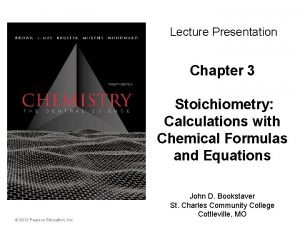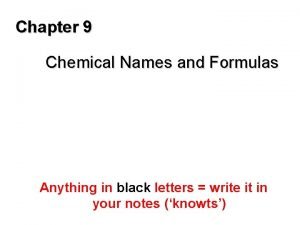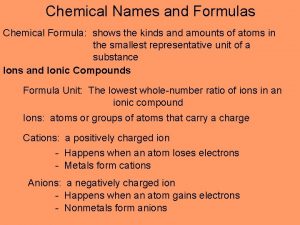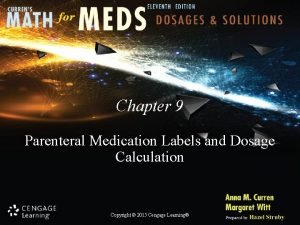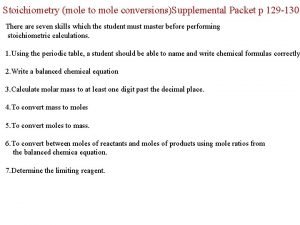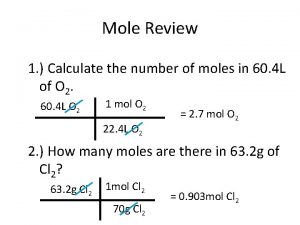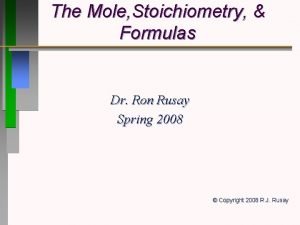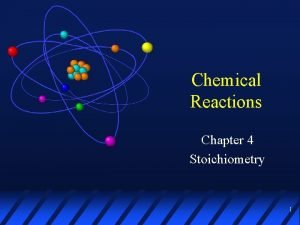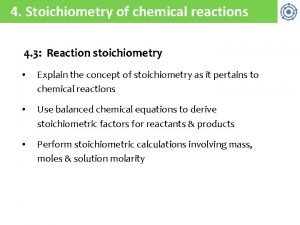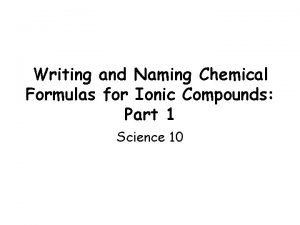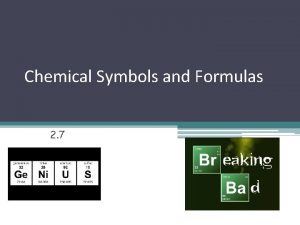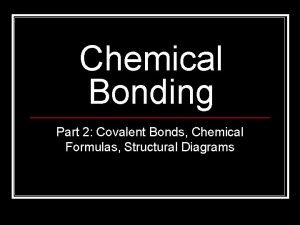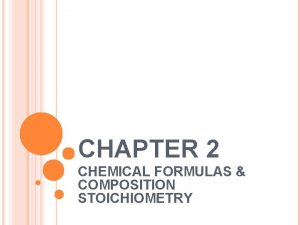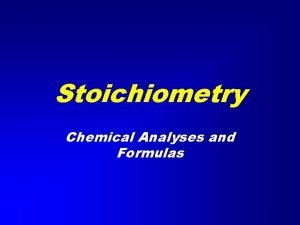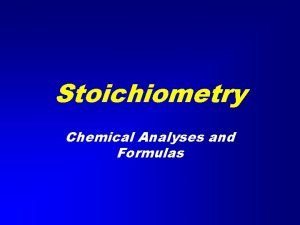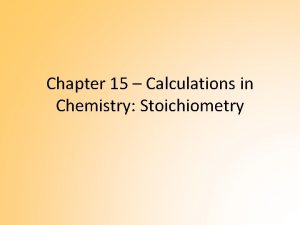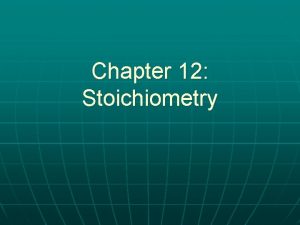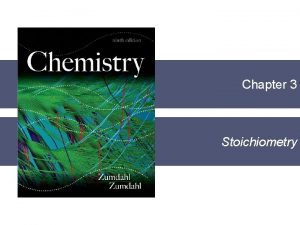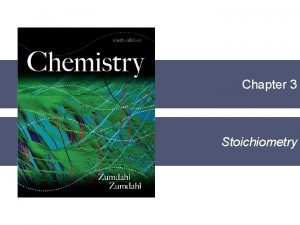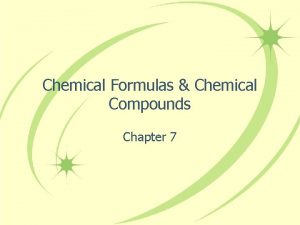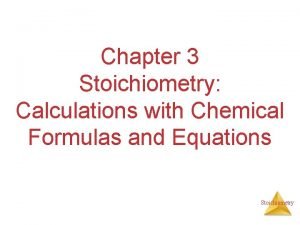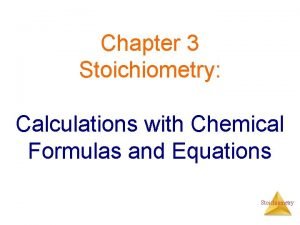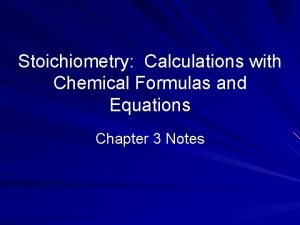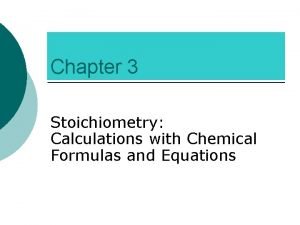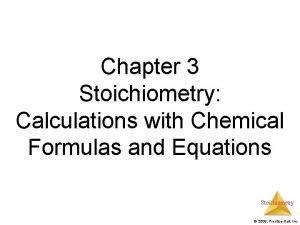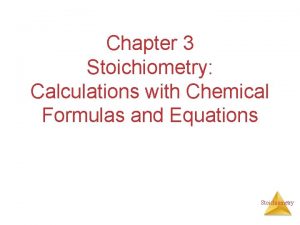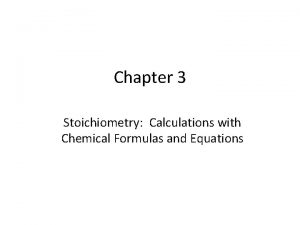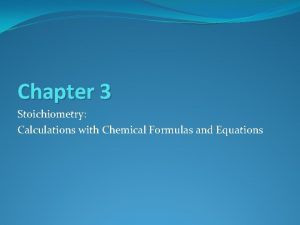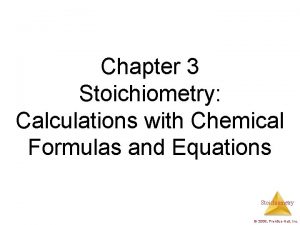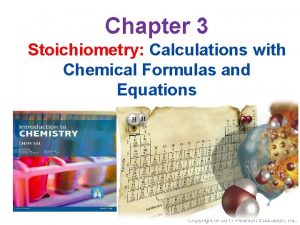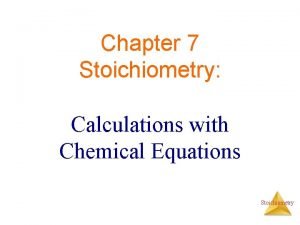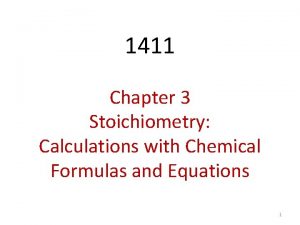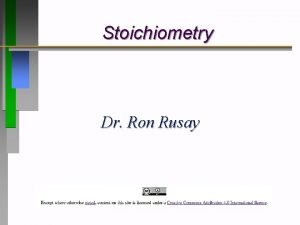Chapter 3 Stoichiometry Calculations with Chemical Formulas and




























- Slides: 28

Chapter 3 Stoichiometry: Calculations with Chemical Formulas and Equations Stoichiometry © 2009, Prentice-Hall, Inc.

Chemical Equations Chemical equations are concise representations of chemical reactions. Stoichiometry © 2009, Prentice-Hall, Inc.

Law of Conservation of Matter n Matter cannot be created nor destroyed. n This means a chemical equation must contain equal number of atoms of each element on the reactant and product sides of the equation, or be balanced. Stoichiometry

Anatomy of a Chemical Equation CH 4 (g) + 2 O 2 (g) Reactants appear on the left side of the equation. CO 2 (g) + 2 H 2 O (g) Stoichiometry © 2009, Prentice-Hall, Inc.

Anatomy of a Chemical Equation CH 4 (g) + 2 O 2 (g) Products appear on the right side of the equation. CO 2 (g) + 2 H 2 O (g) Stoichiometry © 2009, Prentice-Hall, Inc.

Anatomy of a Chemical Equation CH 4 (g) + 2 O 2 (g) CO 2 (g) + 2 H 2 O (g) The states of the reactants and products are written in parentheses to the right of each compound. Stoichiometry © 2009, Prentice-Hall, Inc.

Anatomy of a Chemical Equation CH 4 (g) + 2 O 2 (g) Coefficients are inserted to balance the equation. CO 2 (g) + 2 H 2 O (g) Stoichiometry © 2009, Prentice-Hall, Inc.

Subscripts and Coefficients Give Different Information n Subscripts tell the number of atoms of each element in a molecule. Stoichiometry © 2009, Prentice-Hall, Inc.

Subscripts and Coefficients Give Different Information n Subscripts tell the number of atoms of each element in a molecule n Coefficients tell the number of molecules. Stoichiometry © 2009, Prentice-Hall, Inc.

Moles Stoichiometry © 2009, Prentice-Hall, Inc.

Avogadro’s Number (mole) n 1 mole is a number equal to 6. 02 x 1023 n It also happens that the mass of one mole of an element is equivalent to its atomic mass in grams. Stoichiometry © 2009, Prentice-Hall, Inc.

Percent Composition One can find the percentage of the mass of a compound that comes from each of the elements in the compound by using this equation: % element = (total mass of desired element) (molar mass of the compound) x 100 Stoichiometry © 2009, Prentice-Hall, Inc.

Percent Composition So the percentage of carbon in ethane (C 2 H 6) is… %C = (24. 0 g C) (30. 0 g C 2 H 6) × 100 = 80. 0% Stoichiometry © 2009, Prentice-Hall, Inc.

Stoichiometric Calculations Starting with the mass of Substance A you can use the ratio of the coefficients of A and B to calculate the mass of Substance B formed (if it’s a product) or used (if it’s a reactant). Stoichiometry © 2009, Prentice-Hall, Inc.

Empirical and Molecular Formulas n Empirical Formula – gives formula with lowest, whole number, ratio of subscripts. n CH 2, NH, and C 2 H 2 O are all empirical formulas n Molecular formulas – the formula that shows the actual amount of each atom in a molecule n CH 2, C 2 H 4, C 3 H n NH, N 2 H 2 n C 2 H 2 O, C 4 H 4 O 2 Stoichiometry

Calculating Empirical Formulas n If you are given the masses of all elements in the compound… n Convert to moles of each element n Divide by the smallest number of moles to get ratio n For example, a compound contains 48 grams of carbon and 8 grams of hydrogen, what is its empirical formula? CH 2 is the empirical formula Stoichiometry

Calculating Formulas From Mass Percent n If you are given the percents of the elements in a compound asked to find the empirical formula: n Assume you have a 100 gram sample n Then all of the percents can be thought of as the gram amount in the sample. n Use the same procedure as before. n Determine the empirical formula of a compound that is Stoichiometry

Calculating Empirical Formulas One can calculate the empirical formula from the percent composition. Stoichiometry © 2009, Prentice-Hall, Inc.

warm up How many grams of calcium nitrate, Ca(NO 3)2, contains 24 grams of oxygen atoms? (A) 164 grams (B) 96 grams (C) 62 grams (D) 50. grams (E) 41 grams Stoichiometry

Limiting Reactants Stoichiometry © 2009, Prentice-Hall, Inc.

How Many Cookies Can I Make? n You can make cookies until you run out of one of the ingredients. n Once this family runs out of sugar, they will stop making cookies (at least any cookies you would want to eat). Stoichiometry © 2009, Prentice-Hall, Inc.

How Many Cookies Can I Make? n In this example the sugar would be the limiting reactant, because it will limit the amount of cookies you can make. Stoichiometry © 2009, Prentice-Hall, Inc.

Limiting Reactants n The limiting reactant is the reactant present in the smallest stoichiometric amount. n In other words, it’s the reactant you’ll run out of first (in this case, the H 2). Stoichiometry © 2009, Prentice-Hall, Inc.

Limiting Reactants In the example below, the O 2 would be the excess reagent. Stoichiometry © 2009, Prentice-Hall, Inc.

Theoretical Yield n The theoretical yield is the maximum amount of product that can be made. n In other words it’s the amount of product possible as calculated through the stoichiometry problem. n This is different from the actual yield, which is the amount one actually produces and measures. Stoichiometry © 2009, Prentice-Hall, Inc.

Percent Yield One finds the percent yield by comparing the amount actually obtained (actual yield) to the amount it was possible to make (theoretical yield). Actual Yield Percent Yield = x 100 Theoretical Yield Stoichiometry © 2009, Prentice-Hall, Inc.

Stoichiometry Practice Problems 2. a) 39. 5 g sucrose b) 0. 7577 moles Zn(NO 3)2 c) 6. 0 × 1017 molecules d) 387 g/mol 4. a) C 2 H 6 O, (b) Fe 2 O 3, (c) Na 3 Al. F 6 6. a) 2. 4 mol HF b) 5. 25 g Na. F c) 0. 610 g Na 2 Si. O 3 7. a) 2255 bicycles b) 50 frames and 305 wheels c) handlebars 1 Stoichiometry

n n n (a) 2 Ag. NO 3 (aq) + Cu. Cl 2 (aq) 2 Ag. Cl (s) + Cu(NO 3)2 (aq) (b) 4 Al (s) + 3 O 2 (g) 2 Al 2 O 3 (c) Ba. Cl 2 (aq) + K 2 SO 4 (aq) Ba. SO 4 (s) + 2 KCl (aq) (d) Mg. Cl 2 (s) + 2 Na. OH (s Mg(OH)2 (s) + 2 Na. Cl (aq) (e) 2 KCl. O 3 (s) 2 KCl (s) + 3 O 2 (g) 13. a) 0. 139 Si. C b) 14. 99 g C Stoichiometry
 Empirical formula pogil
Empirical formula pogil Love chemical formula
Love chemical formula Stoichiometric
Stoichiometric Chemical names and formulas chapter 9
Chemical names and formulas chapter 9 Structural steel connection calculations calculations
Structural steel connection calculations calculations Writing formulas criss-cross method worksheet
Writing formulas criss-cross method worksheet Chemistry chapter 9 chemical names and formulas
Chemistry chapter 9 chemical names and formulas Hg3p compound name
Hg3p compound name Dosage calculation formulas
Dosage calculation formulas Dc shunt motor formulas
Dc shunt motor formulas Stoichiometry formulas
Stoichiometry formulas Stoichiometry equation
Stoichiometry equation How to find moles from grams
How to find moles from grams Mole ratio examples
Mole ratio examples Stoichiometry formulas
Stoichiometry formulas Types of chemical reactions and solution stoichiometry
Types of chemical reactions and solution stoichiometry Types of chemical reactions and solution stoichiometry
Types of chemical reactions and solution stoichiometry The calculation of quantities in chemical equations
The calculation of quantities in chemical equations Chemical rxns/balancing equ./stoichiometry
Chemical rxns/balancing equ./stoichiometry Stoichiometry refers to
Stoichiometry refers to Chemical accounting stoichiometry
Chemical accounting stoichiometry Chemical accounting stoichiometry
Chemical accounting stoichiometry Stoichiometry map for chemical reactions
Stoichiometry map for chemical reactions Chapter 11 stoichiometry test
Chapter 11 stoichiometry test In an ionic compound the chemical formula represents
In an ionic compound the chemical formula represents Chemical symbols and formulas
Chemical symbols and formulas The mole formula
The mole formula Covalent compound formula
Covalent compound formula Writing formula from names
Writing formula from names


